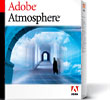
VRML is a standard file format for representing 3-dimensional (3D) interactive vector graphics, designed particularly with the World Wide Web in mind. It has been superseded by X3D.

Second Life is an online multimedia platform that allows people to create an avatar for themselves and then interact with other users and user-created content within a multi-user online virtual world. Developed and owned by the San Francisco–based firm Linden Lab and launched on June 23, 2003, it saw rapid growth for some years and in 2013 it had approximately one million regular users. Growth eventually stabilized, and by the end of 2017 the active user count had declined to "between 800,000 and 900,000". In many ways, Second Life is similar to massively multiplayer online role-playing games; nevertheless, Linden Lab is emphatic that their creation is not a game: "There is no manufactured conflict, no set objective."

Adobe Atmosphere was a software platform for interacting with 3D computer graphics. 3D models created with the commercial program could be explored socially using a browser plugin available free of charge. Atmosphere was originally developed by Attitude Software as 3D Anarchy and was later bought by Adobe Systems. The product spent the majority of its lifetime in beta testing. Adobe released the last version of Atmosphere, version 1.0 build 216, in February 2004, then discontinued the software in December that year.

In computing, an avatar is a graphical representation of a user, the user's character, or persona. Avatars can be two-dimensional icons in Internet forums and other online communities, where they are also known as profile pictures, userpics, or formerly picons. Alternatively, an avatar can take the form of a three-dimensional model, as used in online worlds and video games, or an imaginary character with no graphical appearance, as in text-based games or worlds such as MUDs.
Workspace is a term used in various branches of engineering and economic development.

Image sharing, or photo sharing, is the publishing or transfer of digital photos online. Image sharing websites offer services such as uploading, hosting, managing and sharing of photos. This function is provided through both websites and applications that facilitate the upload and display of images. The term can also be loosely applied to the use of online photo galleries that are set up and managed by individual users, including photoblogs. Sharing means that other users can view but not necessarily download images, and users can select different copyright options for their images.
A virtual tour is a simulation of an existing location, usually composed of a sequence of videos, still images or 360-degree images. It may also use other multimedia elements such as sound effects, music, narration, text and floor map. It is distinguished from the use of live television to affect tele-tourism.

Bing Maps is a web mapping service provided as a part of Microsoft's Bing suite of search engines and powered by the Bing Maps Platform framework which also support Bing Maps for Enterprise APIs and Azure Maps APIs. Since 2020, the map data is provided by TomTom, OpenStreetMap and others.
Open Wonderland is an open-source toolkit written in Java for creating collaborative 3D virtual worlds. Within those worlds, users can communicate with high-fidelity, immersive audio, share live desktop applications and documents and conduct real business. Open Wonderland is completely extensible; developers and graphic artists can extend its functionality to create entirely new worlds including adding new features to existing worlds.
The following outline is provided as an overview of and topical guide to animation:
OZ Virtual was a 3D world viewer created by OZ Interactive that enabled real-time collaboration communications in shared spaces on the Internet with a strong focus on creative content production.

Picture Motion Browser (PMB) is a software application from Sony for organizing and editing digital photos. In 2012, PMB was succeeded by Sony's PlayMemories Home.
Virtual worlds are 3D computer environments where each user is represented with a character – avatar. Traditionally, virtual worlds have been used for entertainment. However, starting from approximately 2004 both corporate world and academia started to recognize business value of virtual worlds for training and education, collaboration, and marketing. Development and maturity of most popular virtual world – Second Life – played a significant role in corporate movement towards virtual worlds for several reasons:

OpenQwaq is open source computer software for immersive collaboration, which enables organizations to implement online 3D virtual world workspaces for their specific needs. OpenQwaq is based on the Teleplace technology, a conferencing platform that has been in the market since 2007, with the name Qwaq Forums until 2009.
Metaio GmbH was a privately held augmented reality (AR) company that was acquired by Apple Inc. in May of 2015. Headquartered in Munich, Germany, with subsidiaries in San Francisco, California, New York City, New York and Dallas, Texas, Metaio provided a software development kit (SDK) for programming PC, web, mobile application and custom offline augmented reality applications. Additionally, Metaio was the creator of Junaio, a free mobile AR browser available for Android and iOS devices.
WebAR, previously known as the Augmented Web, is a web technology that allows for augmented reality functionality within a web browser. It is a combination of HTML5, Web Audio, WebGL, and WebRTC. From 2020s more known as web-based Augmented Reality or WebAR, which is about the use of augmented reality elements in browsers.
Sinespace is a free-to-play massively multiplayer online Unity 3D-based platform created and published by Sine Wave Entertainment. It enables users to create and sell 3D content and interact with others as 3D avatars. It was beta launched in November 2016 and teamed up with Unity to make its SDK available in the Unity Asset Store in March 2019. It supports Oculus Rift, HTC Vive and Windows Mixed Reality headsets, but is also accessible through PC, Mac, Linux, and Chrome web browsers.

NeosVR is a free-to-play, massively multiplayer online, virtual reality application created by Solirax. It was released for free on Microsoft Windows via Steam on May 4, 2018, with support for several VR headsets.

A virtual human is a software fictional character or human being. Virtual human have been created as tools and artificial companions in simulation, video games, film production, human factors and ergonomic and usability studies in various industries, clothing industry, telecommunications (avatars), medicine, etc. These applications require domain-dependent simulation fidelity. A medical application might require an exact simulation of specific internal organs; film industry requires highest aesthetic standards, natural movements, and facial expressions; ergonomic studies require faithful body proportions for a particular population segment and realistic locomotion with constraints, etc.










